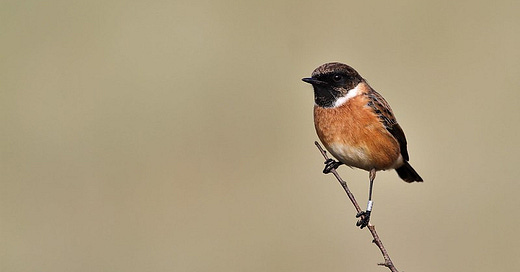The charismatic stonechat is synonymous with gorse, making it a bird of heathlands and many windswept coastal spots, particularly in the west of Britain.
Like the whitethroats and dunnocks with which they often share these places, stonechats have a rapid scratchy warble of a song. Personally I find it completely unmemorable. Even after days walking along clifftops in Wales and Devon listening to this noise I always seem to have forgotten it by the next time.
Thankfully, they have a much more distinctive contact call, which they make all day long, all year round. And it really does sound like stone - more specifically, two small stones being dashed together.
This is the noise with which stonechats will often scold you from a safe distance, and usually helps you to locate the bird along a fence line or balanced on the slimmest of twigs.
Stonechats tend to look quite dumpy, with a head that can look cartoonishly large on their small body, and with a short tail.
They’re busy things, spending much of their time flitting from perch to ground and back again.
The adult male is easily identified, with his dark head, white patch on the neck and brick-orange chest. The females and young birds are trickier, but in all plumages stonechats tend to flick their wings, fidget about and give themselves away with that stony clack.
Next week: Kingfisher
Now booking at Birdsong Academy: autumn half-day walkshops in Sussex and early bird spots on the British Birdsong Essentials course (starting Feb 2022).
Picture credit: Jo Garbutt on Flickr, reproduced under Creative Commons CC BY 2.0



